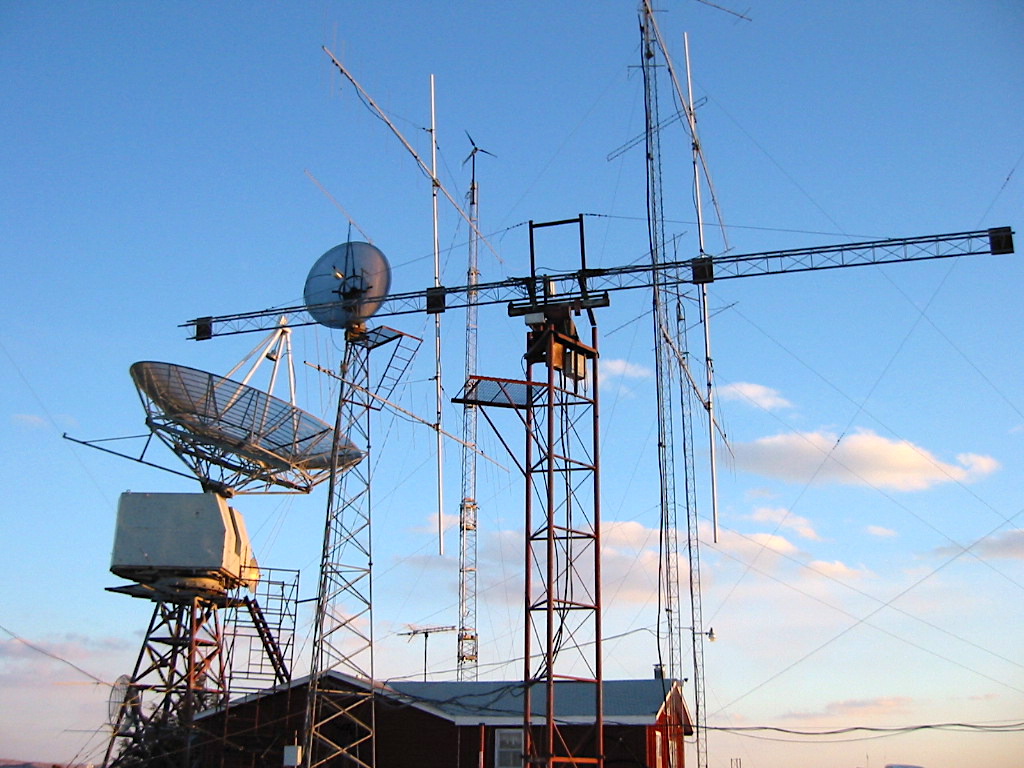
Passions of the Ether
Amateur radio was a huge part of my bicycle travels. I used local repeaters for logistical support, packet to stay in touch with distant friends, HF for entertainment while camping, and 2-meters to stay linked to my YL while pedaling. My hospitality database was full of interesting hams, and we would drop in to share technoid passions for a while… satellites, antenna arrays, microwaves, contests, CW, homebrewing, digital modes, repeater-building, public service, local clubs, traffic handling, and even moonbounce.
It occurred to me that ham radio is not just a hobby, but a complex lifestyle that is much more than geekery. Most communication modes involve other humans, after all, so at its heart it is a social undertaking. And even though the emerging networks were clearly my home, I came to appreciate how much cultural depth lurked behind all the amateur call signs… and the variety of passions that drove people to devote significant resources to their “shacks.” (photo above: QTH of Pete Sias, N0OY)
Although written more than 30 years ago, this is almost timeless because of its cultural focus… even though the technology has evolved hugely and there would now be some added types like digital mode introverts, code warriors, SDR geeks, and micropower WSPRers.
Hams and their reasons to be
by Steven K. Roberts, N4RVE
73 Magazine
October, 1988
It is a rare treat for a writer to contemplate a blank screen on the eve of deadline, trying to get in the mood and feel the audience, then suddenly realize that with every reader he shares a single potent passion. Ham radio is more than a mere vertical market — it’s obsession, religion, and lifestyle of choice for a diverse scattering of technoid humanity. This touches me with something approaching poignance, spawning a temporary departure from the usual theme of this series.
Actually, what started all this was a sort of introspection, the kind of analysis that accompanies any personal expenditure of man-years and kilobucks. Why am I doing this?
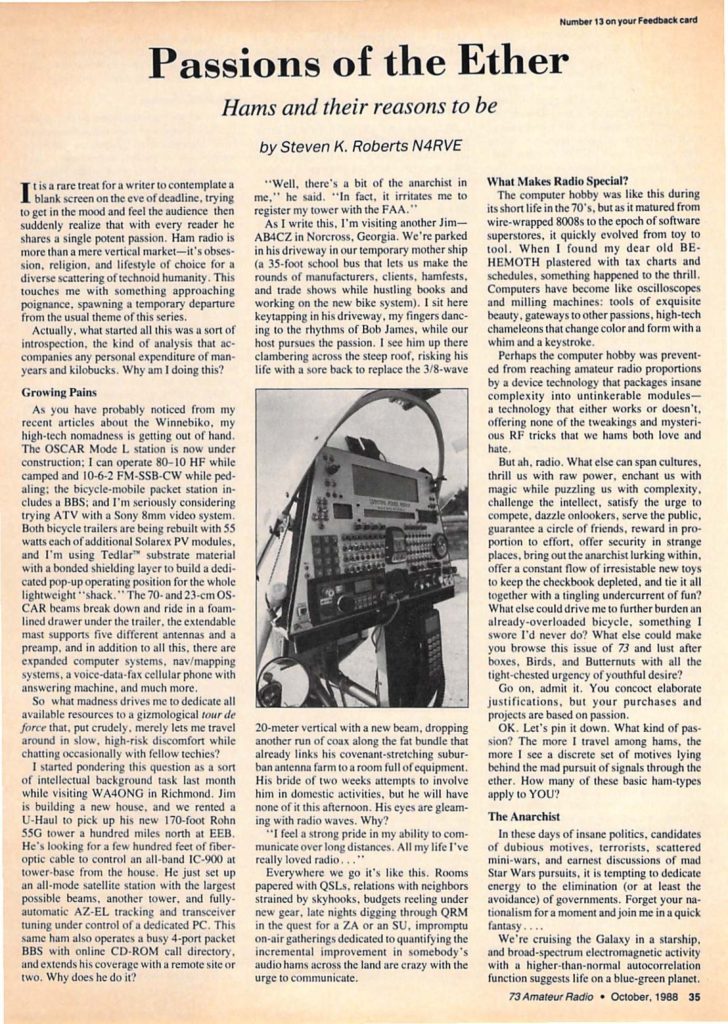
Growing Pains
As you have probably noticed from my recent articles about the Winnebiko, my high-tech nomadness is getting out of hand. The OSCAR Mode L station is now under construction; I can operate 80-10 HF while camped and 10-6-2 FM-SSB-CW while pedaling; the bicycle-mobile packet station includes a BBS; and I’m seriously considering trying ATV with a Sony 8mm video system. Both bicycle trailers are being rebuilt with 55 watts each of additional Solarex PV modules, and I’m using Tedlar™ substrate material with a bonded shielding layer to build a dedicated pop-up operating position for the whole lightweight “shack.” The 70- and 23-cm OSCAR beams break down and ride in a foam-lined drawer under the trailer, the extendable mast supports five different antennas and a preamp, and in addition to all this, there are expanded computer systems, nav/mapping systems, a voice-data-fax cellular phone with answering machine, and much more.
So what madness drives me to dedicate all available resources to a gizmological tour de force that, put crudely, merely lets me travel around in slow, high-risk discomfort while chatting occasionally with fellow techies?
I started pondering this question as a sort of intellectual background task last month while visiting WA4ONG in Richmond. Jim is building a new house, and we rented a U-Haul to pick up his new 170-foot Rohn 55G tower a hundred miles north at EEB. He’s looking for a few hundred feet of fiber optic cable to control an all-band IC-900 at tower-base from the house. He just set up an all-mode satellite station with the largest possible beams, another tower, and fully-automatic AZ-EL tracking and transceiver tuning under control of a dedicated PC. This same ham also operates a busy 4-port packet BBS with online CD-ROM call directory, and extends his coverage with a remote site or two. Why does he do it?
“Well, there’s a bit of the anarchist in me.” he said. “In fact, it irritates me to register my tower with the FAA.” As I write this, I’m visiting another Jim — AB4CZ in Norcross, Georgia. We’re parked in his driveway in our temporary mothership (a 35-foot school bus that lets us make the rounds of manufacturers, clients, hamfests, and trade shows while hustling books and working on the new bike system). I sit here keytapping in his driveway, my fingers dancing to the rhythms of Bob James, while our host pursues the passion. I see him up there clambering across the steep roof, risking his life with a sore back to replace the 3/8-wave 20-meter vertical with a new beam, dropping another run of coax along the fat bundle that already links his covenant-stretching suburban antenna farm to a room full of equipment. His bride of two weeks attempts to involve him in domestic activities, but he will have none of it this afternoon. His eyes are gleaming with radio waves. Why?
“I feel a strong pride in my ability to communicate over long distances. All my life I’ve really loved radio…”
Everywhere we go it’s like this. Rooms papered with QSLs, relations with neighbors strained by skyhooks, budgets reeling under new gear, late nights digging through QRM in the quest for a ZA or an SU, impromptu on-air gatherings dedicated to quantifying the incremental improvement in somebody’s audio… hams across the land are crazy with the urge to communicate.
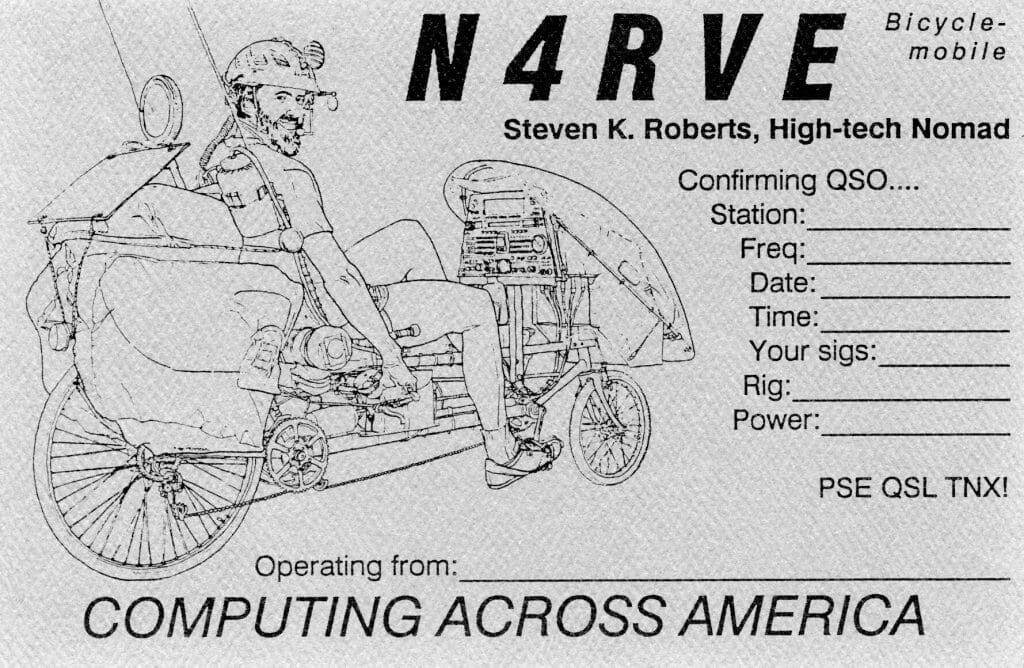
What Makes Radio Special?
The computer hobby was like this during its short life in the 70’s, but as it matured from wire-wrapped 8008s to the epoch of software superstores, it quickly evolved from toy to tool. When I found my dear old homebrew machine plastered with tax charts and schedules, something happened to the thrill. Computers have become like oscilloscopes and milling machines: tools of exquisite beauty, gateways to other passions, high-tech chameleons that change color and form with a whim and a keystroke.
Perhaps the computer hobby was prevented from reaching amateur radio proportions by a device technology that packages insane complexity into untinkerable modules — a technology that either works or doesn’t, offering none of the tweakings and mysterious RF tricks that we hams both love and hate.
But ah, radio. What else can span cultures, thrill us with raw power, enchant us with magic while puzzling us with complexity, challenge the intellect, satisfy the urge to compete, dazzle onlookers, serve the public, guarantee a circle of friends, reward in proportion to effort, offer security in strange places, bring out the anarchist lurking within, offer a constant flow of irresistible new toys to keep the checkbook depleted, and tie it all together with a tingling undercurrent of fun? What else could drive me to further burden an already-overloaded bicycle, something I swore I’d never do? What else could make you browse this issue of 73 and lust after boxes, Birds, and Butternuts with all the light-chested urgency of youthful desire?
Go on, admit it. You concoct elaborate justifications, but your purchases and projects are based on passion.
OK. Let’s pin it down. What kind of passion? The more I travel among hams, the more I see a discrete set of motives lying behind the mad pursuit of signals through the ether. How many of these basic ham-types apply to YOU?
The Anarchist
In these days of insane politics, candidates of dubious motives, terrorists, scattered mini-wars, and earnest discussions of mad Star Wars pursuits, it is tempting to dedicate energy to the elimination (or at least the avoidance) of governments. Forget your nationalism for a moment and join me in a quick fantasy…
We’re cruising the Galaxy in a starship, and broad-spectrum electromagnetic activity with a higher-than-normal autocorrelation function suggests life on a blue-green planet.
Discreetly we hover, all sensors on. Initial conclusion: a single intertwined ecosystem, dominated by a single intelligent species.
Looking closer and extracting meaning from the jumble of transmissions, however, we begin to observe that the planet is criss-crossed with boundaries, some following natural geographic features, others imaginary. Different abstract regions, populated by the same species, spend 10-20% of every individual’s income on the tools of warfare. Humans crossing imaginary lines can be harrassed, searched, taxed, imprisoned, or killed. Artificial trade restrictions exist, raising the overhead of living.
Radio waves have no respect for borders. When they are wielded by humans who feel likewise, the result is a refreshing sense of freedom from the artificial constraints of governmental policy. Even though an American ham can’t ask an Irish ham to call a friend in Dublin, the capability is there; even though there are places where ham radios are considered spy equipment, it’s good to know that if it all hits the fan, we amateurs will be there to help knit humans together. Every new station, be it a packet BBS or a 1.2 Gig HT, adds to the general ability of our species to keep itself from dissolution.
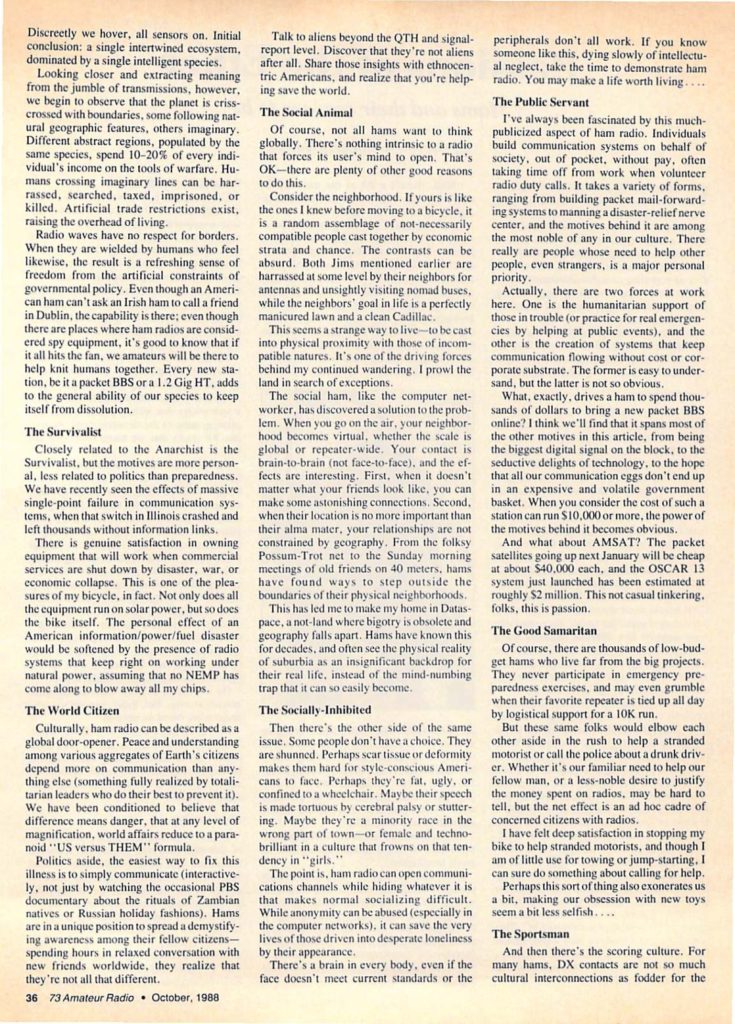
The Survivalist
Closely related to the Anarchist is the Survivalist, but the motives are more personal, less related to politics than preparedness. We have recently seen the effects of massive single-point failure in communication systems, when that switch in Illinois crashed and left thousands without information links.
There is genuine satisfaction in owning equipment that will work when commercial services are shut down by disaster, war, or economic collapse. This is one of the pleasures of my bicycle, in fact. Not only does all the equipment run on solar power, but so does the bike itself. The personal effect of an American information/power/fuel disaster would be softened by the presence of radio systems that keep right on working under natural power, assuming that no NEMP has come along to blow away all my chips.
The World Citizen
Culturally, ham radio can be described as a global door-opener. Peace and understanding among various aggregates of Earth’s citizens depend more on communication than anything else (something fully realized by totalitarian leaders who do their best to prevent it). We have been conditioned to believe that difference means danger, that at any level of magnification, world affairs reduce to a paranoid “US versus THEM” formula.
Politics aside, the easiest way to fix this illness is to simply communicate (interactively, not just by watching the occasional PBS documentary about the rituals of Zambian natives or Russian holiday fashions). Hams are in a unique position to spread a demystifying awareness among their fellow citizens — spending hours in relaxed conversation with new friends worldwide, they realize that they’re not all that different.
Talk to aliens beyond the QTH and signal-report level. Discover that they’re not aliens after all. Share those insights with ethnocentric Americans, and realize that you’re helping save the world.
The Social Animal
Of course, not all hams want to think globally. There’s nothing intrinsic to a radio that forces its user’s mind to open. That’s OK — there are plenty of other good reasons to do this.
Consider the neighborhood. If yours is like the ones I knew before moving to a bicycle, it is a random assemblage of not-necessarily compatible people cast together by economic strata and chance. The contrasts can be absurd. Both Jims mentioned earlier are harassed at some level by their neighbors for antennas and unsightly visiting nomad buses, while the neighbors’ goal in life is a perfectly manicured lawn and a clean Cadillac.
This seems a strange way to live — to be cast into physical proximity with those of incompatible natures. It’s one of the driving forces behind my continued wandering. I prowl the land in search of exceptions.
The social ham, like the computer networker, has discovered a solution to the problem. When you go on the air, your neighborhood becomes virtual, whether the scale is global or repeater-wide. Your contact is brain-to-brain (not face-to-face), and the effects are interesting. First, when it doesn’t matter what your friends look like, you can make some astonishing connections. Second, when their location is no more important than their alma mater, your relationships are not constrained by geography. From the folksy Possum-Trot net to the Sunday morning meetings of old friends on 40 meters, hams have found ways to step outside the boundaries of their physical neighborhoods.
This has led me to make my home in Dataspace, a not-land where bigotry is obsolete and geography falls apart. Hams have known this for decades, and often see the physical reality of suburbia as an insignificant backdrop for their real life, instead of the mind-numbing trap that it can so easily become.
The Socially-Inhibited
Then there’s the other side of the same issue. Some people don’t have a choice. They are shunned. Perhaps scar tissue or deformity makes them hard for style-conscious Americans to face. Perhaps they’re fat, ugly, or confined to a wheelchair. Maybe their speech is made tortuous by cerebral palsy or stuttering. Maybe they’re a minority race in the wrong part of town — or female and techno-brilliant in a culture that frowns on that tendency in “girls.”
The point is, ham radio can open communications channels while hiding whatever it is that makes normal socializing difficult. While anonymity can be abused (especially in the computer networks), it can save the very lives of those driven into desperate loneliness by their appearance.
There’s a brain in every body, even if the face doesn’t meet current standards or the peripherals don’t all work. If you know someone like this, dying slowly of intellectual neglect, take the time to demonstrate ham radio. You may make a life worth living
The Public Servant
I’ve always been fascinated by this much-publicized aspect of ham radio. Individuals build communication systems on behalf of society, out of pocket, without pay, often taking time off from work when volunteer radio duty calls. It takes a variety of forms, ranging from building packet mail-forwarding systems to manning a disaster-relief nerve center, and the motives behind it are among the most noble of any in our culture. There really are people whose need to help other people, even strangers, is a major personal priority.
Actually, there are two forces at work here. One is the humanitarian support of those in trouble (or practice for real emergencies by helping at public events), and the other is the creation of systems that keep communication flowing without cost or corporate substrate. The former is easy to understand, but the latter is not so obvious.
What, exactly, drives a ham to spend thousands of dollars to bring a new packet BBS online? I think we’ll find that it spans most of the other motives in this article, from being the biggest digital signal on the block, to the seductive delights of technology, to the hope that all our communication eggs don’t end up in an expensive and volatile government basket. When you consider the cost of such a station can run $10,000 or more, the power of the motives behind it becomes obvious.
And what about AMSAT? The packet satellites going up next January will be cheap at about $40,000 each, and the OSCAR 13 system just launched has been estimated at roughly $2 million. This not casual tinkering, folks, this is passion.
The Good Samaritan
Of course, there are thousands of low-budget hams who live far from the big projects. They never participate in emergency preparedness exercises, and may even grumble when their favorite repeater is tied up all day by logistical support for a 10K run.
But these same folks would elbow each other aside in the rush to help a stranded motorist or call the police about a drunk driver. Whether it’s our familiar need to help our fellow man, or a less-noble desire to justify the money spent on radios, may be hard to tell, but the net effect is an ad-hoc cadre of concerned citizens with radios.
I have felt deep satisfaction in stopping my bike to help stranded motorists, and though I am of little use for towing or jump-starting, I can sure do something about calling for help.
Perhaps this sort of thing also exonerates us a bit, making our obsession with new toys seem a bit less selfish….
The Sportsman
And then there’s the scoring culture. For many hams, DX contacts are not so much cultural interconnections as fodder for the coveted “Worked More Than 100 Countries on Less Than 33 Watts While Eating Burritos in the Snow” award. These contacts have a formula look about them, and there have been rumors of robot contest ops that compete effectively.
Some people run contests for the glory. Others for the exercise. Others for a concentrated dose of that enchantment that comes with working every new state or country (I ran about 150 QSOs on Field Day as a casual one-delta for this reason). Some do it to receive external, objective feedback on the effectiveness of their station. And still others do it to add excitement to the process of advancing the state of the art in communication techniques (collecting meteor-scatter grid squares).
As with most aspects of ham radio, the question of motive is mired in complexity. Clearly, there is thrill in competition, and some of the more sophisticated forms of “radiosport” reward not the bucks spent on big guns, but the hours spent on fine-tuning receive efficiency and operating skills.
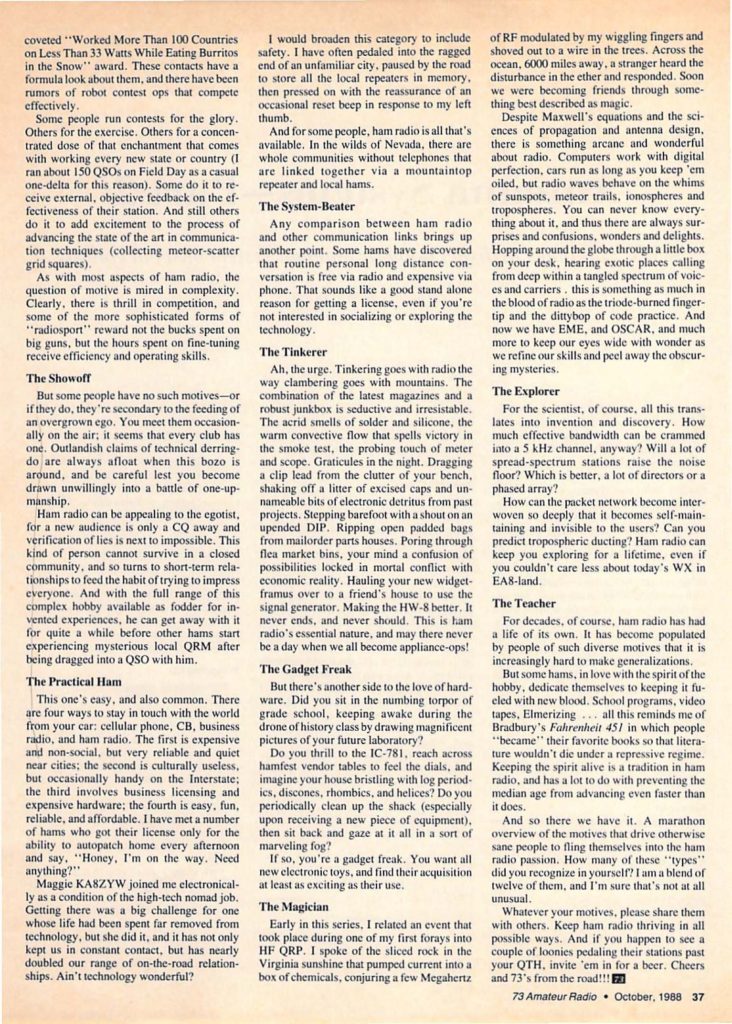
The Showoff
But some people have no such motives — or if they do, they’re secondary to the feeding of an overgrown ego. You meet them occasionally on the air; it seems that every club has one. Outlandish claims of technical derring-do are always afloat when this bozo is around, and be careful lest you become drawn unwillingly into a battle of one-upmanship.
Ham radio can be appealing to the egotist, for a new audience is only a CQ away and verification of lies is next to impossible. This kind of person cannot survive in a closed community, and so turns to short-term relationships to feed the habit of trying to impress everyone. And with the full range of this complex hobby available as fodder for invented experiences, he can get away with it for quite a while before other hams start experiencing mysterious local QRM after being dragged into a QSO with him.
The Practical Ham
This one’s easy, and also common. There are four ways to stay in touch with the world from your car: cellular phone, CB, business radio, and ham radio. The first is expensive and non-social, but very reliable and quiet near cities; the second is culturally useless, but occasionally handy on the Interstate; the third involves business licensing and expensive hardware; the fourth is easy, fun, reliable, and affordable. I have met a number of hams who got their license only for the ability to autopatch home every afternoon and say, “Honey, I’m on the way. Need anything?”
Maggie KA8ZYW joined me electronically as a condition of the high-tech nomad job. Getting there was a big challenge for one whose life had been spent far removed from technology, but she did it, and it has not only kept us in constant contact, but has nearly doubled our range of on-the-road relationships. Ain’t technology wonderful?
I would broaden this category to include safety. I have often pedaled into the ragged end of an unfamiliar city, paused by the road to store all the local repeaters in memory, then pressed on with the reassurance of an occasional reset beep in response to my left thumb.
And for some people, ham radio is all that’s available. In the wilds of Nevada, there are whole communities without telephones that are linked together via a mountaintop repeater and local hams.
The System-Beater
Any comparison between ham radio and other communication links brings up another point. Some hams have discovered that routine personal long distance conversation is free via radio and expensive via phone. That sounds like a good standalone reason for getting a license, even if you’re not interested in socializing or exploring the technology.
The Tinkerer
Ah, the urge. Tinkering goes with radio the way clambering goes with mountains. The combination of the latest magazines and a robust junkbox is seductive and irresistible. The acrid smells of solder and silicone, the warm convective flow that spells victory in the smoke test, the probing touch of meter and scope. Graticules in the night. Dragging a clip lead from the clutter of your bench, shaking off a litter of excised caps and unnameable bits of electronic detritus from past projects. Stepping barefoot with a shout on an upended DIP. Ripping open padded bags from mail-order parts houses. Poring through flea market bins, your mind a confusion of possibilities locked in mortal conflict with economic reality. Hauling your new widgetframus over to a friend’s house to use the signal generator. Making the HW-8 better. It never ends, and never should. This is ham radio’s essential nature, and may there never be a day when we all become appliance-ops!
The Gadget Freak
But there’s another side to the love of hardware. Did you sit in the numbing torpor of grade school, keeping awake during the drone of history class by drawing magnificent pictures of your future laboratory?
Do you thrill to the IC-781, reach across hamfest vendor tables to feel the dials, and imagine your house bristling with log periodics, discones, rhombics, and helices? Do you periodically clean up the shack (especially upon receiving a new piece of equipment), then sit back and gaze at it all in a sort of marveling fog?
If so, you’re a gadget freak. You want all new electronic toys, and find their acquisition at least as exciting as their use.
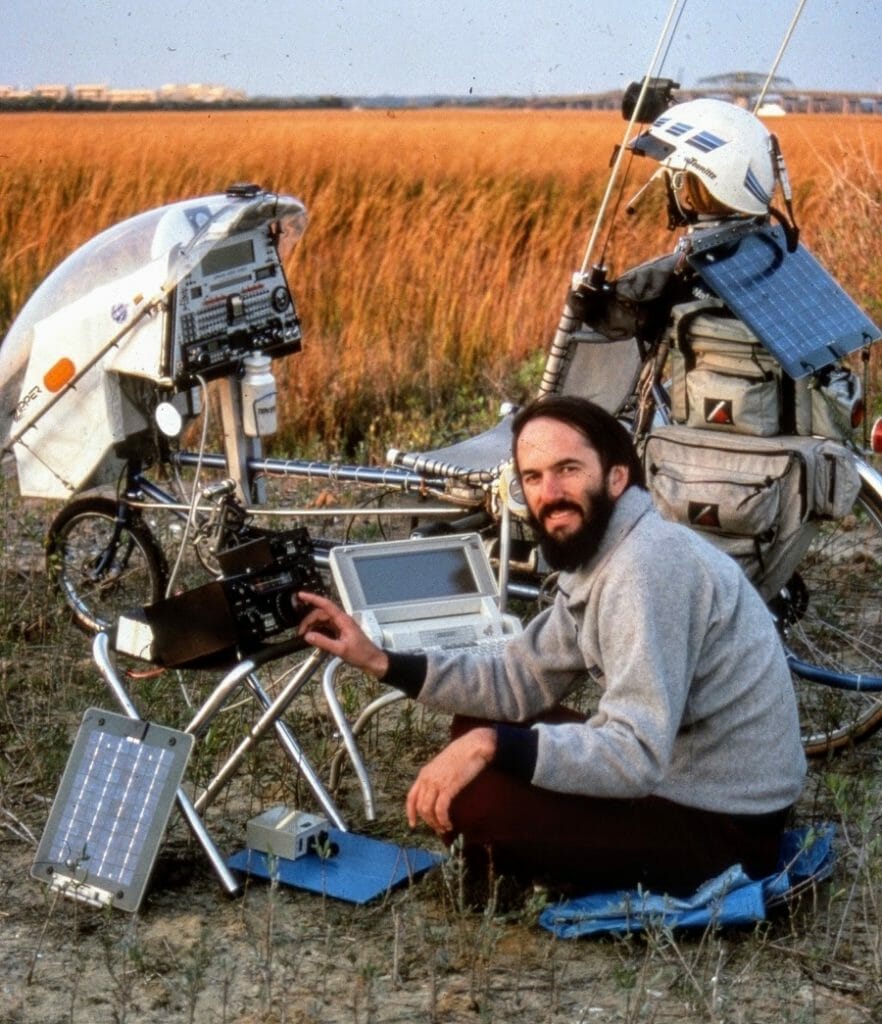
The Magician
Early in this series, I related an event that took place during one of my first forays into HF QRP. I spoke of the sliced rock in the Virginia sunshine that pumped current into a box of chemicals, conjuring a few Megahertz of RF modulated by my wiggling fingers and shoved out to a wire in the trees. Across the ocean, 6000 miles away, a stranger heard the disturbance in the ether and responded. Soon we were becoming friends through something best described as magic.
Despite Maxwell’s equations and the sciences of propagation and antenna design, there is something arcane and wonderful about radio. Computers work with digital perfection, cars run as long as you keep ’em oiled, but radio waves behave on the whims of sunspots, meteor trails, ionospheres and tropospheres. You can never know everything about it, and thus there are always surprises and confusions, wonders and delights. Hopping around the globe through a little box on your desk, hearing exotic places calling from deep within a tangled spectrum of voices and carriers… this is something as much in the blood of radio as the triode-burned finger tip and the dittybop of code practice. And now we have EME, and OSCAR, and much more to keep our eyes wide with wonder as we refine our skills and peel away the obscuring mysteries.
The Explorer
For the scientist, of course, all this translates into invention and discovery. How much effective bandwidth can be crammed into a 5 kHz channel, anyway? Will a lot of spread-spectrum stations raise the noise floor? Which is better, a lot of directors or a phased array?
How can the packet network become interwoven so deeply that it becomes self-maintaining and invisible to the users? Can you predict tropospheric ducting? Ham radio can keep you exploring for a lifetime, even if you couldn’t care less about today’s WX in EA8-land.
The Teacher
For decades, of course, ham radio has had a life of its own. It has become populated by people of such diverse motives that it is increasingly hard to make generalizations.
But some hams, in love with the spirit of the hobby, dedicate themselves to keeping it fueled with new blood. School programs, video tapes, Elmerizing… all this reminds me of Bradbury’s Fahrenheit 451 in which people “became” their favorite books so that literature wouldn’t die under a repressive regime. Keeping the spirit alive is a tradition in ham radio, and has a lot to do with preventing the median age from advancing even faster than it does.
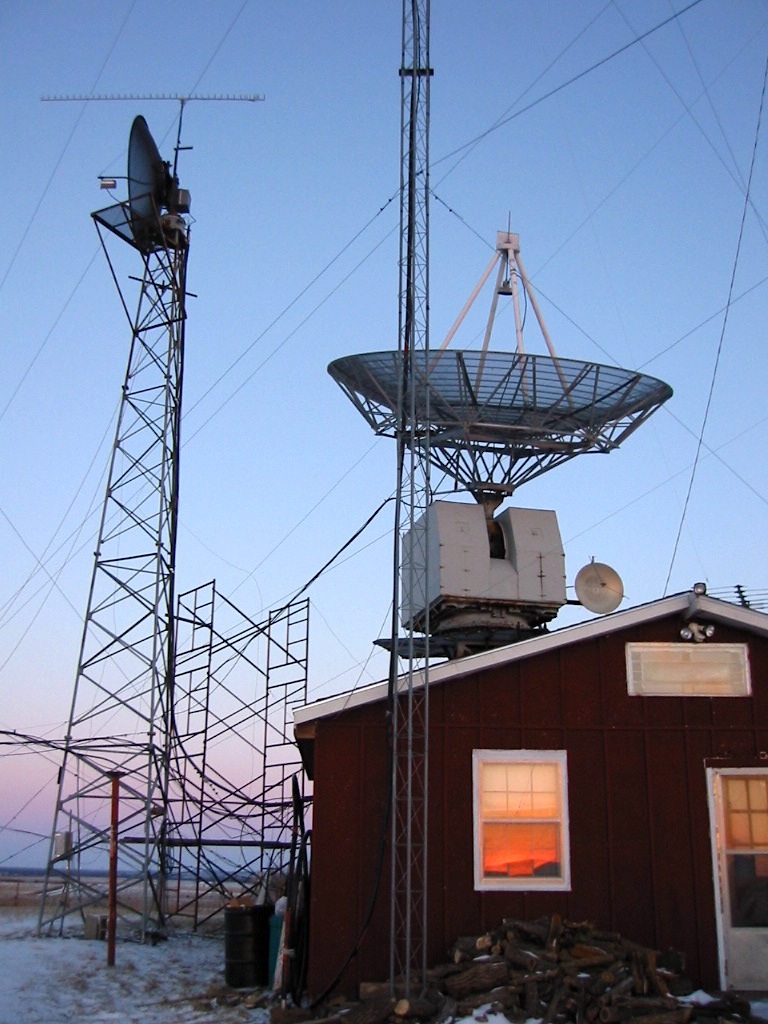
And so there we have it: a marathon overview of the motives that drive otherwise sane people to fling themselves into the ham radio passion. How many of these “types” did you recognize in yourself? I am a blend of twelve of them, and I’m sure that’s not at all unusual.
Whatever your motives, please share them with others. Keep ham radio thriving in all possible ways. And if you happen to see a couple of loonies pedaling their stations past your QTH, invite ’em in for a beer. Cheers and 73’s from the road!!!


You must be logged in to post a comment.